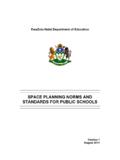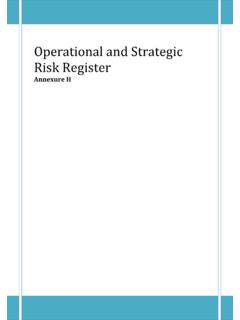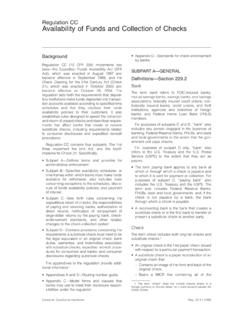Transcription of PLANNING AND PRIORITIZATION PROCESS - KZN …
1 1 PLANNING AND PRIORITIZATION PROCESS Introduction Infrastructure PLANNING and prioritisation takes place in the provincial education environment and depending on the capacity of the Provincial Education Departments concerned this PROCESS has been conducted to differing levels of acceptability to both the National Treasury and the Department of Basic Education. The PRIORITIZATION PROCESS has also been an area of concern, since how priorities match national and known provincial targets has been a subject of some debate and disagreement especially when budgets reach the MTEC Stage in budget submission and approval. An additional matter of concern is that relating to the extent to which School Principals and their respective Schools Governing Bodies (SGB s) have been adequately involved in a PROCESS that leads to the determination of targeted educational outcomes.
2 Another issue of crucial importance is that relating to the establishment of a maintenance plan for schools and the sets of responsibilities expected of school principals and SGBs in schools maintenance. It is therefore proposed that the PLANNING PROCESS for the determination of backlogs and the establishment of Medium Term Expenditure Framework (MTEF) budgets and project lists also address circuit and district priorities. The following draft PROCESS map sets out some of the steps that can be taken towards the achievement of participative gap analysis, prioritisation of needs, the determination of project lists, and circuit, district and provincial priorities in MTEF budgets together with a rational and well motivated set of iteratively tested outcomes. The steps proposed do not in any way imply that the steps need to be conducted in a sequential manner since it is possible that due to levels of capacity and experience prevailing in the provinces some of the proposed steps can be conducted in parallel.
3 Step 1 Ideally school principals and SGBs will need to engage to clarify their respective sets of needs to achieve quality educational learning and teaching outcomes. Each school identifies their infrastructure needs and includes them in their annual School Improvement Plan for approval by the School Governing Body. These needs should be submitted in the form of a letter to the respective Circuit Manager. This letter together with these lists can be used by the SGB in its interaction with parents and teachers to endorse their respective concerns going forward. This feedback can be crucial in securing the involvement of stakeholders in future PLANNING processes. 2 Step 2 First at circuit level the circuit managers can, using a standard template, aggregate the lists of schools together with additional information relating to backlogs in infrastructure services (water, sanitation, electricity, fencing and condition of schools) and future needs in terms of classrooms, specialised learning spaces, administration spaces and maintenance requirements.
4 Capacity at this level will determine the extent to which circuit teams will be able to adequately address this step. Support from the District or Province might be required to make this input to the PLANNING PROCESS . The result is a list of all schools in the circuit showing the needs per school. Step 3 During this step the circuit officials will be able to organise the circuit priorities using the filled-in templates already completed. A PROCESS of checking will need to be conducted via visits to schools or with reference to some institutional knowledge held by the officials. The circuit will rank the needs for the schools in the circuit and mark the most important projects as priorities. The ranked list will be submitted to the District office. Where capacity is lacking at the circuit, this ranking PROCESS can be completed by a district official.
5 Step 4 The district official collates the ranked circuit lists into prioritised district lists for each project type, using a standard template provided by the Provincial office. At this stage the district teams will have established a preliminary scoping for the proposed interventions at each school. The Provincial Department of Education can in a Workshop format conduct a participative exercise involving district teams of officials, and where relevant one or more implementing agents. Using the templates completed by each of the district teams a presentation is made by each District team setting out the priorities of the district in terms of the top 50 or 100 schools requiring attention in accordance with the prescribed type of intervention required. Discussion will in all probability take place where some verification and discussion will ensue to reach consensus around issues where doubt exists.
6 In an interactive PROCESS the Provincial Infrastructure PLANNING Team will populate the MTEF framework with the prioritised list of projects, with the remaining and outstanding projects being placed into a holding position for later consideration. At this stage the district teams will have established a preliminary scoping and costing estimate of interventions proposed. In an interactive exercise an action plan will need to be formulated to indicate how a set of challenges could be met going forward. Such challenges could include matters such as; classrooms needed to meet enrolment numbers, 3 social management challenges, the rationalisation/merging of schools separated by a fence, consolidation/closure of schools with insufficient learners The outcome of this workshop will be an interactively generated prioritised list of projects by category of intervention and stage of intervention.
7 Copies of these lists would then be given to each of the District teams to take back to their respective constituencies to demonstrate the rationale and collectively generated outcomes from the Workshop. These lists can then be used to indicate and secure buy-in by the circuit and school principals and SGBs of the PROCESS to which each had contributed in a transparent manner. It is important to note that both the PLANNING for and follow-up to this workshop needs to be an actively managed PROCESS conducted by provincial officials supported by the relevant IDIP TAs in each of the provinces. Step 5 Step 5 will address the provincial PRIORITIZATION PROCESS that will comprise an evaluation of the district prioritised lists already populated in the MTEF framework as set against the prevailing provincial targets and priorities, targets identified by the media, commitments made by the MECs and political imperatives.
8 The outcome of this step will constitute a thumb-suck set of initial cost estimates that will be a first run of the MTEF project list and budget. During the budgeting PROCESS the provincial office uses general guidelines to allocate the budget: 1. Allocate funds to projects already contracted (these are contractual commitments); 2. Allocate funds for repairs and providing mobile classrooms at schools with emergencies exposed electrical cables, roofs blown off, floods and other situations that are clearly emergencies; 3. Allocate funds to national priorities as per guidance from the national office; 4. Allocate funds to new infrastructure, upgrades and additions at existing facilities, rehabilitation and maintenance, using the proportions approved by the HOD and captured in the U-AMP and IPMP; 5.
9 Ensure that the worst affected schools are addressed first; 6. Ensure equitable distribution across districts depending on the population, condition and access to educational facilities. 4 Step 6 This step will embrace the initial scoping and allocation of the proposed budget going forward and will use as a baseline those estimates of the scope of work earlier estimated by the District teams in their submissions to the District PRIORITIZATION Workshop. This iterative PROCESS will undoubtedly need to check the accuracy of the information submitted by the district teams and follow-up any discrepancies with the relevant and appropriate district and circuit managers. Once verified these prioritised lists of projects will be will be a second run of the MTEF project list and budget to be inserted into a preliminary version of the User Asset Management Plans (U-AMPS) of each provincial education department.
10 Step 7 Step 7 constitutes a milestone stage in the PLANNING and PRIORITIZATION PROCESS as it involves the MTEF Budget and Project Lists being confirmed as inputs to the U-AMPS and subsequently the Infrastructure Programme Management Plan (IPMP). Step 8 This step comprises the detailed project scoping, budgeting and design stages to confirm the project brief before project implementation. Proper feedback loops ensure that the results of this stage update the MTEF, and that District and circuit officials are aware of the final scope of work to be implemented at each school. As depicted in the draft PROCESS map all the eight (8) steps alluded to in the diagram address some specific actions and exercises currently envisaged as relevant to Gate 1 in the IDM Toolkit Gateway PROCESS . Step 9 Detailed project scoping, budgeting and design results in the tender documents and pre-tender cost estimate.

















